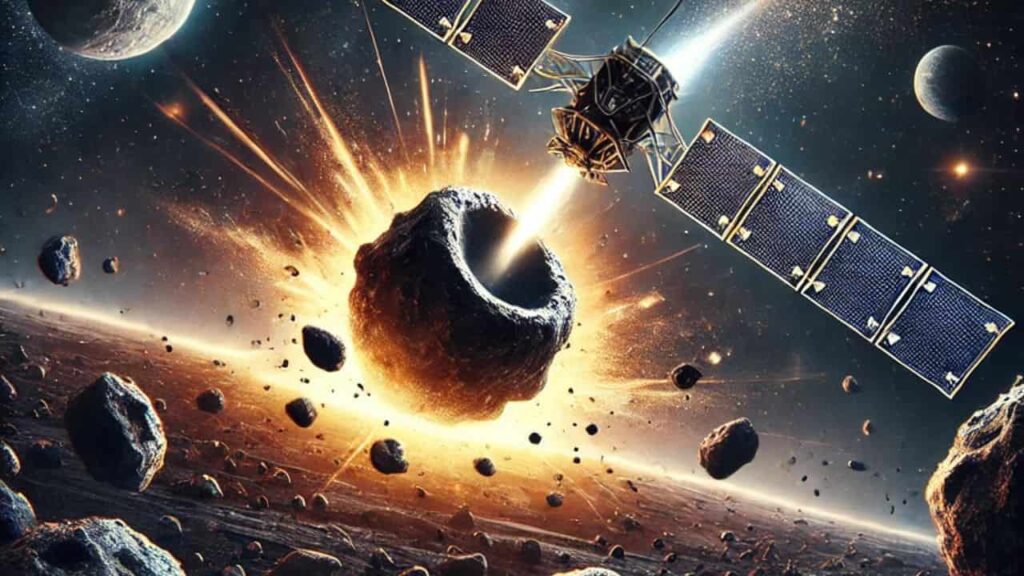NASA DART mission, binary asteroid system, Dimorphos, Didymos, asteroid collision, planetary defense, asteroid geology, NASA discoveries, space exploration, asteroid impact, DART success
Discover the groundbreaking findings from NASA’s DART mission as it sheds light on the origins and evolution of the binary asteroid system, Dimorphos and Didymos. Learn how this mission enhances planetary defense and contributes to our understanding of asteroid geology.

NASA’s DART Mission Sheds New Light on Target Binary Asteroid System
In 2022, NASA’s Double Asteroid Redirection Test (DART) mission sent a spacecraft to intentionally collide with the asteroid moonlet Dimorphos, part of the binary asteroid system along with its parent asteroid Didymos. This mission aimed to test our ability to redirect an asteroid’s path, a vital capability for planetary defense. Recent analysis of data collected from this mission has revealed significant insights into the origins and evolution of this binary asteroid system, as well as why the DART spacecraft was so effective in altering Dimorphos’ orbit.
New Discoveries from DART Mission
In five recently published papers in Nature Communications, the DART mission’s science team explored the geology of the binary asteroid system. These studies have provided a comprehensive understanding of the physical characteristics, origin, and evolution of Dimorphos and Didymos.
Geological Analysis of Dimorphos and Didymos
Thomas Statler, the lead scientist for Solar System Small Bodies at NASA Headquarters, emphasized the importance of these findings. “These findings give us new insights into the ways that asteroids can change over time,” he said. “This is important not just for understanding the near-Earth objects that are the focus of planetary defense but also for our ability to read the history of our Solar System from these remnants of planet formation.”
Olivier Barnouin and Ronald-Louis Ballouz from Johns Hopkins Applied Physics Laboratory (APL) led one of the papers analyzing the geology of both asteroids. Using images captured by DART and its accompanying LICIACube cubesat, the team observed that Dimorphos’ topography featured boulders of varying sizes. In contrast, Didymos appeared smoother at lower elevations but was rocky at higher elevations with more craters. The researchers inferred that Dimorphos likely spun off from Didymos in a large mass shedding event.
Natural processes can accelerate the spins of small asteroids, and evidence suggests these processes might be responsible for reshaping these bodies or even forcing material to spin off their surfaces. The analysis indicated that both Didymos and Dimorphos have weak surface characteristics. The team estimated Didymos’ surface age to be 12.5 million years, while Dimorphos’ surface age was less than 300,000 years. The low surface strength of Dimorphos likely contributed to the significant impact DART had on its orbit.
Insights from Boulders and Surface Characteristics
Maurizio Pajola from the National Institute for Astrophysics (INAF) in Rome, along with co-authors, led a paper comparing the shapes, sizes, and distribution patterns of boulders on the two asteroids. They determined that Dimorphos likely formed from material inherited from Didymos, supporting the theory that some binary asteroid systems arise from remnants of a larger primary asteroid accumulating into a new moonlet.
Alice Lucchetti, also from INAF, and her team found that thermal fatigue—gradual weakening and cracking due to heat—could rapidly break up boulders on Dimorphos’ surface. This process could generate surface lines and alter the physical characteristics of such asteroids more quickly than previously thought. The DART mission likely provided the first observation of this phenomenon on this type of asteroid.
Surface Bearing Capacity and Boulders Analysis
Under the supervision of researcher Naomi Murdoch from ISAE-SUPAERO in Toulouse, France, students Jeanne Bigot and Pauline Lombardo led a study to determine Didymos’ bearing capacity. They found it to be at least 1,000 times lower than dry sand on Earth or lunar soil. Understanding this parameter is crucial for predicting the response of a surface, including for asteroid displacement purposes.
Colas Robin, also from ISAE-SUPAERO, and co-authors analyzed the surface boulders on Dimorphos, comparing them with those on other rubble pile asteroids such as Itokawa, Ryugu, and Bennu. The researchers found that the boulders shared similar characteristics, suggesting that these types of asteroids formed and evolved in a similar manner. They also noted that the elongated boulders around the DART impact site likely formed through impact processing.
Implications for Planetary Defense and Future Missions
These latest findings provide a more robust overview of the origins of the Didymos system and contribute to our understanding of how such planetary bodies form. The European Space Agency’s Hera mission, scheduled to revisit the DART collision site in 2026, will further analyze the aftermath of this first-ever planetary defense test. The research from the DART mission provides a series of tests for what Hera might find, aiding in current and future exploration missions while enhancing planetary defense capabilities.
Johns Hopkins APL managed the DART mission for NASA’s Planetary Defense Coordination Office as a project of the agency’s Planetary Missions Program Office. NASA provided support for the mission from several centers, including the Jet Propulsion Laboratory in Southern California, Goddard Space Flight Center in Greenbelt, Maryland, Johnson Space Center in Houston, Glenn Research Center in Cleveland, and Langley Research Center in Hampton, Virginia.
Conclusion
The DART mission’s success in altering Dimorphos’ orbit and the wealth of data collected have significantly advanced our understanding of binary asteroid systems. The geological analysis of Dimorphos and Didymos has provided insights into their origin and evolution, shedding light on the processes that shape such bodies over time. The mission’s findings not only enhance our planetary defense strategies but also offer valuable information for future missions exploring similar asteroid systems. As we continue to study these remnants of planet formation, we gain a deeper understanding of our Solar System’s history and the dynamic processes that continue to shape it.
Read More
- Top 5 Best 6K & 8K Cameras for Filmmaking 2023
- Top 5 BEST Humidifiers of 2023
- Top 5 BEST Handheld Vacuums of 2023
- NASA and Sierra Space Dream Chaser Arrives in Florida for Launch Prep










